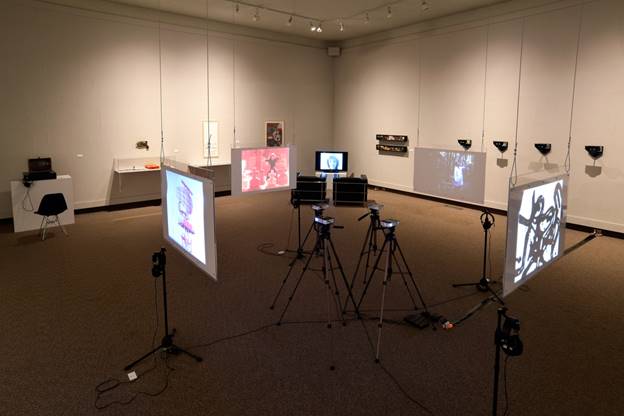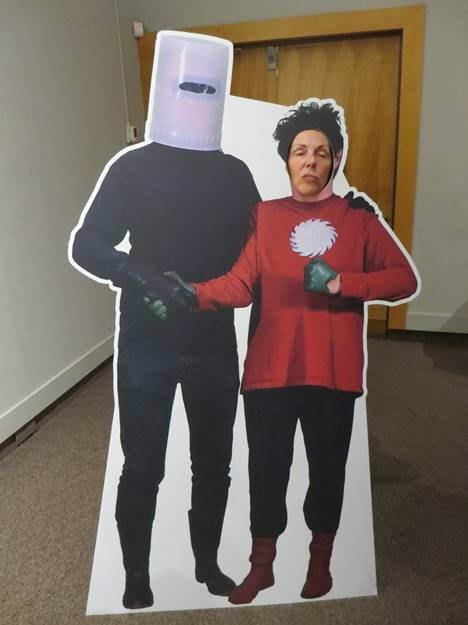
On November 4, 2016 I spoke at the Meet in the Middle, Stations of Migration and Memory Between Art and Film International Symposium at the MacKenzie Art Gallery in Regina, Saskatchewan. The following are the things that I should have said (I spoke more off the cuff with these slides and these ideas, but I fell far off my script). Terms such as “self-appropriation” came up the following day and been added here just to make me sound a bit more smarter-like.

This summer, in July and August, Strandline featured me as station 6 of the “Meet In the Middle” project. The exhibition drew from 30 years of my film and video work: “my life’s work”. This was an honour but was also frightening. Life is about the journey, not about the destination. Does this mean I am at the end?

Let me take a moment to address the topic of this panel of presentations: memory, migration, and trauma. I’ll be talking about memory. Everyone has had trauma, but it is a relative thing. Most of mine involves surgeon’s scalpels but end with being surrounded by loved ones, so I’d be egotistical to describe this as traumatic today among my colleagues here. Migration also has numerous definitions. I return to Regina. It is where my work is rooted. Geographic migration is not a part of my creative work. Following Atom’s description yesterday, I could say that I’ve migrated between media, from single channel film into a gallery practice. This may be true but I see it more as a migration between communities rather than between media. The people that program, install, attend, and discuss art gallery work are different than those doing similar things for film. As such, I have been migrating into that community of people for years, so the recent action of actually placing of my work in the gallery is not an abrupt shift of communities; it is almost a natural evolution. As the film community fragmented over the past few years in Saskatchewan, the act of working and showing has become more indirect and impersonal while experiencing art in a gallery gives one a more direct response with the work and with others experiencing the work.

This brings me back to memory. When Christine Ramsay and Elizabeth Matheson approached me with this project, I began thinking. I didn’t begin watching, I began remembering all the things I made, reviewing them in my mind. I found that I remember the processes, the mistakes, and the regrets over what I did wrong or what I’d failed to do within each project.

Many of my projects took two more years to create. As such, like a journey, there were detours taken and some paths rejected. I wish I could go back and take some of those detours now, perhaps invent a few more with my 2016 eyes. For example, one act of self-appropriation was with “Angst”, a film I shot with performer Dawn Henderson in 1989. Filmed partially in studio, partially on the streets, and all at night, it was my first foray into a city scape project and I’d always wanted to return to this. In recent years I have also become interested in old technologies and how they connect us to space and memory in different ways. I decided to make stereoscopic viewers and views to re-examine this film through old technology. I restaged selected scenes of “Angst” for three D viewing, ironically making the project contemporary again.


In “Dread”, I had recorded over 30 hours of phone messages, many of which I never listened to, over a two year span in the early 1990s. In the original film, I layered these voices in the soundtrack to create a sense of confusion, but decades later I am no longer interested in this unfocused expression of life. Instead, I now seek clarity and understanding. I have sorted the messages, grouping them by age, gender, attitude, or any other criteria I could determine from the otherwise anonymous recordings, and presented them to gallery-goers to listen to via old dial telephones. This medium brings the listener close to the voice and creates a physical connection with the hand set. The listener is forced to treat the sound clips as immediate but also archival with the deeply personal aspects of them being unavoidable.


The paintings displayed here are from the opening “Agoraphobia” scene from “Wheat Soup”. I played an artist so created these as props for that film. They are one piece of the exhibition that I have not attempted to make a new response to because I cannot do much better that this today, having not really developed my drawing or painting skills, but could no longer capture the naïve nature of them, this many decades later. I would only do them discredit. I only kept them because a very influential professor of mine liked hem and told me to, even though when I offered to let him have them he refused them. Also displayed here are note books and journals; pieces of hand writing which have since been replaced by my blog, but are extensions of my memory. Reading them should prove activities of the past, but my memory is so imprecise that I even doubt my own hand sometimes.

“Wheat Soup”, finished in 1987, took years to create. I am very proud to have been part of this collaboration with everyone involved doing such interesting things. During this production, basically 1984-87, I changed as a filmmaker. What I liked about the film at the beginning, the story, jokes, and the play on the genre, changed to an interest in the form, the exploration of space, and the narrative critique of the medium. In response to “Wheat Soup”, I created a short film “The End of Another Day”, shot using similar lens as the sunset shot from the earlier film. It also features two characters and a voice over conversation, but differs primarily in the thoughts I have, the care behind each word, and the flow and structure of the overall scene. It is set in the same world as “Wheat Soup”, but years later, and is the spirit of how I would like to remember having written the original film.


I used the small gage, 8mm film for my late 90s project “25 Short Films In and Around Saskatchewan” to explore small aspects of this province, its history, landscape, light, etc. Now, instead of studying more space with the medium, I used a microscope to explore the medium with another medium. Frames of film, re-photographed, were enlarged and displayed in the gallery. Looking closely, I question how I remember my obsessions with these short documents.

Finally we reach new work, the series of projects related to Canister the Robot. Over the past decade I have come to rely on my blog, my videos, and my photo archive to remember most things I have done and, to some extent, to remember who I am. I realize that I am the construct I am building electronically and as such, I am subject to my own mistakes and lies. Canister was created as a bit of a joke, an invader from space who came to earth in the 1960s but became a cultural icon instead of a conqueror. To establish this, I have designed toys, games, record albums, Saturday morning cartoons, colouring books, and comic books with his voice or image. Mechanical reproduction, suggested by both his robot nature and by the mass market representations of him, carries with it the inevitable degradation of ideas through generation loss. The robot is my fear of forgetting. He is faceless and almost without personality, he is presence without identity. Through him, I ask the question “how many lies do I need to construct before I make up the truth?” In the climax of the meta-story, Canister contains an explosion inside of his head which becomes a universe-creating big bang in which he becomes the god of the universe inside his own head. Unable to fathom such a role, he redefines himself as a single individual, the perpetually optimistic “Mr. Saul”, another of my on-screen personas. I made him, so in his arrogance he needed to make me back.

At least that is the way I remember it.
Photo credits: Trevor Hopkin except "Sand up Caniter" and "End of Another Day"; Gerald Saul